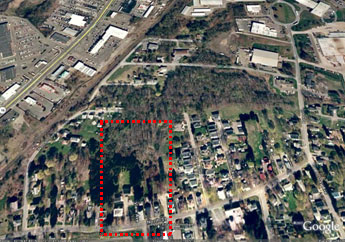Terrain.org is an online journal devoted to smart growth that’s integrated with the natural environment. It won a 1999 Media Award for Sustainable Development, and has an entire category devoted to UnSprawl. Randall Arendt’s article, “Cultivating Natural and Cultural Landscapes through Conservation Subdivision Design”, is a good example of increasing sensitivity among Smart Growth advocates for development that respects existing natural features and key elements of neighborhood character. Some excerpts:
If you have ever driven by a development site both before and after construction, you will probably have noticed how drastically the pre-existing landscape–both natural and cultural–has been altered, sometimes almost beyond recognition. Very typically, woodlands have been felled, hedgerows have been pulled up and cleared away, the natural contours of the terrain have been ironed out into dead-flat building platforms, drainages have been relocated, old houses and barns have been razed.
Usually not as obvious is the lack of necessity for many of those changes, which forever impoverish the community by permanently erasing special features that are often impossible to replace or replicate. The loss of habitat, familiar landscapes, and character-defining buildings are often the result of indifference by developers and their engineering consultants, and ignorance of practical alternatives by local planning staffs and officials who approve such proposals, based on outdated zoning and subdivision codes which legitimize this kind of corporate and municipal misbehavior…
At the heart of [“conservation planning”] is the idea that the residential subdivision design process can be reformed so that such developments become a major tool for achieving a community’s conservation objectives, at no additional cost to developers. In fact, studies have shown they save money on expensive site grading and street construction, and that the lots tend to sell more quickly and at premium prices…
The critically-important first step consists of inventorying resources worth designing around and preserving, either because they represent daunting obstacles to development (such as wetlands, floodplains, and steep slopes), or because they encompass special value-adding natural or cultural features that are extremely vulnerable because they are NOT located in unbuildable areas…
View slideshow of 25 cultural, natural, and restoration features of conservation subdivision design >>
See also:
Photo Essay: Our Woods in Winter
Here are pictures taken yesterday from the bike path and roads surrounding the woods behind North Street. Kohl Construction proposes to build 26 condo units in and around these woods. As observed in Preserving and Enhancing Communities: A Guide for Citizens, Planners, and Policymakers,
Protecting open space is often about protecting what makes a community special and unique… At the small-town or village scale, a forested hillside or surrounding farmland helps create a unique sense of place. Furthermore, preserving open space helps to create distinct edges that stop the blurring of community boundaries that is characteristic of urban sprawl. Defining what is unique about one’s community and identifying places that are special to local residents is an important part of the overall planning process (Hester 1990)…Photo Essay: Millyard Brook Swells with Water in Winter
Above: The woods as seen from Northern Avenue.
Above: This house at 8 View Avenue is slated for demolition. It is to be replaced by a road and Unit 17.
Photo Essay: The Forest Behind View Avenue
Kohl’s Condo Proposal: Where Things Stand, and What You Can Do

The urban forest behind North Street is already surrounded by development.

The proposed condos will encroach close to wetlands.


Roads and parking spaces will need to be constructed to serve the condos.

[Note: Northampton Redoubt reports that Units 28-31 have been dropped from the plan as they are close to probable vernal pools. One unit has also been dropped from the group of three at the end of Northern Avenue.]
Pictures of Kohl Construction’s Condo Plans
[These condos are slated to go into a neighborhood of 1-3 family detached homes. At a 2/7/08 meeting of Northampton’s Planning Board, one member characterized condo developments like these as “carbuncles”, as they are out of character and poorly integrated with their surroundings.]

Greening Smart Growth: The Sustainable Sites Initiative
The presence of natural elements has several implications for personal and community security. Shared green spaces, particularly those with trees, provide settings for people to interact and strengthen social ties. Residential areas with green surroundings are associated with greater social cohesion in neighborhoods, and neighbors with stronger social ties are more likely to monitor local activity, intervene if problem behaviors occur,[48] and defend their neighborhoods against crime.[49] Residents of buildings with greater tree and grass cover report fewer incidences of vandalism, graffiti, and litter than counterparts in more barren buildings.[50] Likewise, a study comparing police reports of crime and extent of tree and grass cover found that the greener a building’s surroundings, the fewer total crimes were reported.[51]
Rutherford Platt, “Regreening the Metropolis: Pathways to More Ecological Cities”
Loss of signature trees or groves to disease or development may devalue real estate, impair sense of place, and cause emotional distress. Conversely, the protection of a special tree or stand of timber strengthens the communal sense of place…
The Ecological Cities Project: Greenspace in “The Humane Metropolis”
The “humane metropolis” advocates, bent on shared streets and spaces, have no single solution. Their idea is simply to protect and create all possible natural areas — parks, greenways, forest tracts — fostering a shared sense of “ecological stewardship.” They’re strongly for promotion of urban gardening and farm markets. They support efforts toward environmental justice, so that low-income areas are not burdened with undue, damaging pollution.
Smart Growth with Balance: The American Planning Association [emphasis added]
Core principles of Smart Growth include:
…CREATION OR PRESERVATION OF A “SENSE OF PLACE”. A “sense of place” results when design and development protect and incorporate the distinctive character of a community and the particular place in which it is located. Geography, natural features, climate, culture, historical resources, and ecology each contribute to the distinctive character of a region…

